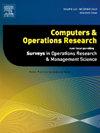An approximation algorithm for multi-allocation hub location problems
IF 4.1
2区 工程技术
Q2 COMPUTER SCIENCE, INTERDISCIPLINARY APPLICATIONS
引用次数: 0
Abstract
The multi allocation -hub median problem (MApHM), the multi allocation uncapacitated hub location problem (MAuHLP) and the multi allocation -hub location problem (MApHLP) are common hub location problems with several practical applications. HLPs combine the task of constructing a network and solving a routing on that network. Specifically, a set of hubs must be chosen and each routing must be performed using one or two hubs as stopovers. The costs between two hubs are discounted by a parameter . The objective is to minimize the total transportation cost in the MApHM and additionally to minimize the set-up costs for the hubs in the MAuHLP and MApHLP. In this paper, an approximation algorithm to solve these problems is developed, which improves the approximation bound for MAuHLP to 2.408.
The proposed algorithm reduces the HLPs to Facility Location Problems (FLPs), incorporating the idea of preferring hubs in the direction of the destination. Depending on the HLP, different FLP approximation algorithms with approximation bound are used. In cases where the discount factor satisfies or , the resulting approximation bound still improves upon the current state of the art.
The proposed algorithm is capable of solving much bigger instances than any exact algorithm in the literature. New benchmark instances have been created and published, such that HLP algorithms can be tested and compared on standardized huge instances. There, the proposed algorithm outperformed the previous best approximation algorithm in nearly all test instances.
多分配轮毂定位问题的近似算法
多分配p-hub中值问题(MApHM)、多分配无能力hub定位问题(MAuHLP)和多分配p-hub定位问题(maplp)是具有多种实际应用的常见枢纽定位问题。hlp结合了构建网络和解决该网络上的路由问题的任务。具体来说,必须选择一组集线器,并且必须使用一个或两个集线器作为中途停留点来执行每个路由。两个枢纽之间的成本用参数α折现。目标是最小化mapphm中的总运输成本,另外最小化mahlp和mapphlp中的枢纽的设置成本。本文提出了一种求解这些问题的近似算法,将MAuHLP的近似界提高到2.408。该算法将hlp问题简化为设施定位问题(FLPs),并结合了在目的地方向上选择集线器的思想。根据HLP的不同,使用了近似界为γ的不同FLP近似算法。在折现因子满足0<;α<;1γ或α≥0.619的情况下,得到的近似界在目前技术水平上仍有改进。所提出的算法能够解决比文献中任何精确算法更大的实例。已经创建并发布了新的基准实例,这样HLP算法就可以在标准化的大型实例上进行测试和比较。在几乎所有的测试实例中,提出的算法都优于之前的最佳逼近算法。
本文章由计算机程序翻译,如有差异,请以英文原文为准。
求助全文
约1分钟内获得全文
求助全文
来源期刊

Computers & Operations Research
工程技术-工程:工业
CiteScore
8.60
自引率
8.70%
发文量
292
审稿时长
8.5 months
期刊介绍:
Operations research and computers meet in a large number of scientific fields, many of which are of vital current concern to our troubled society. These include, among others, ecology, transportation, safety, reliability, urban planning, economics, inventory control, investment strategy and logistics (including reverse logistics). Computers & Operations Research provides an international forum for the application of computers and operations research techniques to problems in these and related fields.
 求助内容:
求助内容: 应助结果提醒方式:
应助结果提醒方式:


